Snowmobile Sales Benefitted from Strong Winter
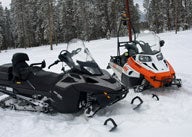
North American sled sales up while international sales fall
Here at my solitary Minnesota-based satellite editorial office, things tend to get so slow that I actually look forward to attending the annual Polaris shareholders meeting. Held at the company’s corporate office in Medina, Minn., the location is relatively close by. The event is usually informative and sometimes a harbinger of corporate strategies. But, as the company celebrates 60 years of existence, Polaris has diversified and become very much a global corporation and not a singular snowmobile manufacturer as it started out in 1954.
Today snowmobiles account for a mere 8% of Polaris’ total sales. The Parts, Garments and Accessories (PGA) element of the company generates more than twice the revenue and 16% of total sales. The star of the company remains Off-Road Vehicles (side-by-sides and ATVs), which lead the charts with US$2.5 billion in sales, which makes up 67% of Polaris’ US$3.8 billion in annual revenues.
So, when you attend a Polaris shareholder meeting, the executives no longer wax poetic about a great snow season. Those days are gone, even though the heritage aspect of the snowmobile’s importance remains. Polaris has become quite diversified and international. It has a Defense sector, a fledgling Brutus line of commercial power products, a selection of electric-powered vehicles and two motorcycle product lines – Victory and Indian. Snowmobiles have a place, but it isn’t as big sales-wise as it once was.
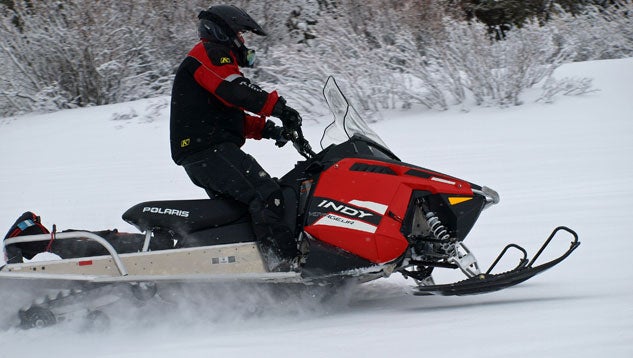 Snowmobile manufacturers pay attention to sales outside the US and Canada as they develop special units like this long-tracked Polaris Voyageur to appeal to riders where trails are few, but versatility is essential.
Snowmobile manufacturers pay attention to sales outside the US and Canada as they develop special units like this long-tracked Polaris Voyageur to appeal to riders where trails are few, but versatility is essential.Still, I sat at the shareholder meeting and reviewed the end-of-the fiscal year documents looking for insights to help preview our small world of snowmobiles. There was a surprise or two.
According to Polaris President Bennett Morgan, “The North American snowmobile industry concluded its strongest season in five years with industry retail up just over 10% and industry dealer inventories in excellent shape down strong double-digits.
Beyond 2015: What Does the Snowmobile Future Hold?
“For the season Polaris’ retail grew mid-single digits,” Morgan said. “We gave back a little of our significant share gains over the past five years to share losses in the mountains caused by weak pre-season sales last spring and prior year RMK quality hiccups.”
But, he was upbeat. “Despite our modest share erosion this season, we are optimistic for the upcoming season. Our dealer inventory is in very good shape and is down year-over-year on model 2014. Our model year 2014 snowmobile quality was excellent and our model year 2015 snowmobile introductions were very significant and well received by both dealers and consumers. We introduced what we believe is the strongest product news in the industry led by our all new AXYS next generation chassis which is featured by nine RUSH performance and Switchback crossover segment products.”
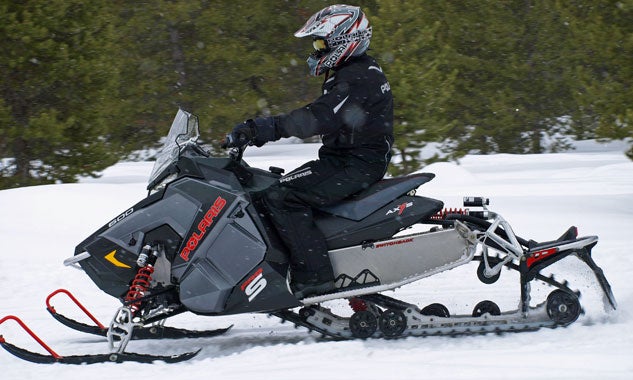 When we come off a good winter and dealer inventories are low, sled makers hit us with new technologies like Polaris’ AXYS-equipped Switchback.
When we come off a good winter and dealer inventories are low, sled makers hit us with new technologies like Polaris’ AXYS-equipped Switchback.Responding to questions during a teleconference with stock analysts, Polaris’ president noted “our snowchecks actually were considerably better than we expected year-over-year… there has been some weakness in the European snow market in the first quarter and we think their orders are going to be impacted.”
Although expecting a rosier outlook, I understood the caution on Polaris’ part as Morgan noted: “The first quarter European snow industry slowed due to poor snow and was down double digits in Q1… (There) was some impact on model year 2015 European snowmobile orders.”
There appears to be uneasiness about the impact Europe’s poor snow season will have as Morgan later confirmed, “They had a pretty lousy snow season, didn’t have good snow coverage for most of the year, and that’s affected the snowmobile orders.”
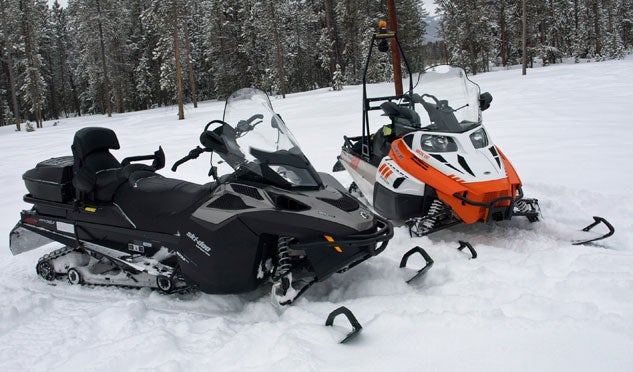 Unique snowmobiles like the Ski-Doo Expedition and Arctic Cat Bearcat GS fill the need for reliable winter transportation in parts of the snow world.
Unique snowmobiles like the Ski-Doo Expedition and Arctic Cat Bearcat GS fill the need for reliable winter transportation in parts of the snow world.He expressed concern that between the Russian and Scandinavian markets, overall volume could end up being a little less than half of what it had been last season. As you may recall, 2012-2013 industry sled sales outside of North America represented 36% of total sales – or more than 50,000 units. If these estimates are correct, that puts international unit sales at the lowest it’s been since 2010. So, it’s a good thing that North America did well, because industry experts feel that overall unit sales will reflect growth.
One Year Later: The Arctic Cat/Yamaha Deal
When issuing guidance for stock analysts, all three North American snowmobile producers exercise caution. Artic Cat expects to grow its retail sales to prerecession levels. The Thief River Falls, Minn. based company states that its wholesale sled sales grew 7% and that it estimates a 5-8-percentage growth of retail snowmobile sales for the snowmobile industry. To move profitability ahead, Arctic Cat reports that its retail sales grew about 23% and that it expected to end its 2014 fiscal year with a 21% market share. Currently Arctic Cat snowmobiles represent 39% of the company’s volume versus 16% for PGA and 45% for its wheeled products.
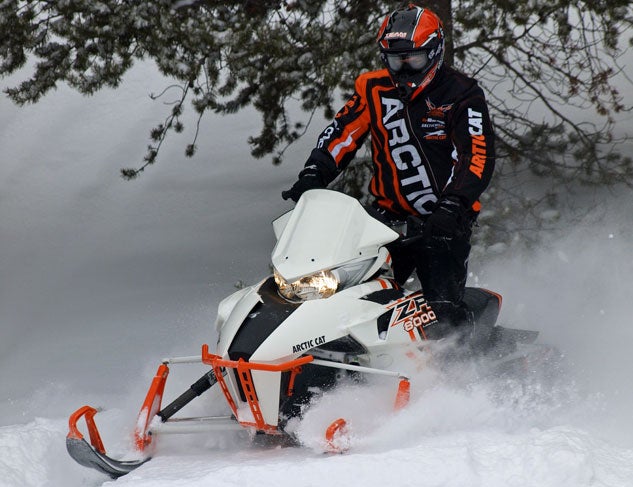 Sled makers like Arctic Cat count on our memories of the past snowy winter and fun-riding driving strong fall sled sales.
Sled makers like Arctic Cat count on our memories of the past snowy winter and fun-riding driving strong fall sled sales.“As we all know, the winter season has been very long in North America, with excellent snow coverage, all of course leading to a very strong snowmobile season,” stated BRP/Ski-Doo’s Jose Boisjoli as he addressed stock analysts during a teleconference. “This industry growth was much better than what we had anticipated. And when we look at the Ski-Doo inventory at dealers, it is at a historical low level. As of January 31, the North American snowmobile industry and BRP retail were up mid-double digit.”
But, like his counterparts at Polaris and Arctic Cat, Boisjoli projects caution with sled sales outside North America. “On the international side, despite below-average snow coverage, the Scandinavia snowmobile industry is up low-single digit, with BRP retail up high-single digit season-to-date. Note that the Scandinavia season ends at the end of June, versus the North America season, which ends at the end of March.
Looking Back at Three Million Ski-Doos
“The Russia market was more difficult this year due to poor snow coverage; and there is no doubt that the political and economic instability is having an impact on our retail performance. Russia is a key market for us, and the significant decline in the ruble in the past six months versus the euro most certainly puts pressure on profitability and the demand in that market. We are therefore prudent in our planning for the upcoming fiscal year.”
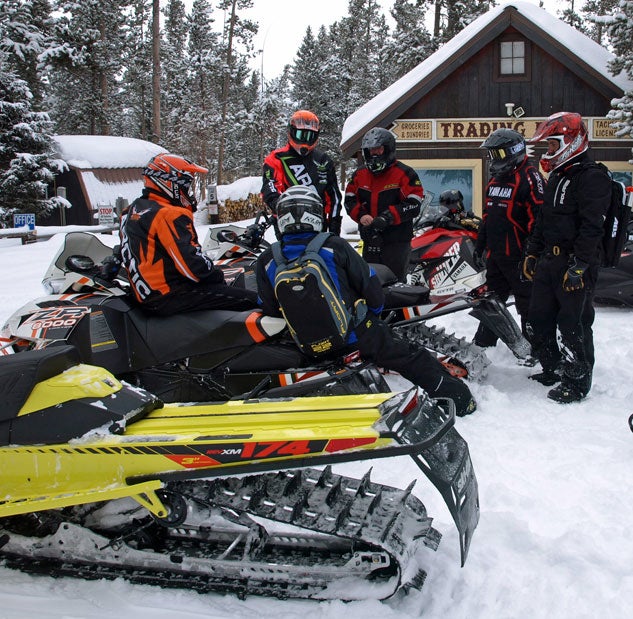 Regardless of the sled brand you ride, there is nothing like getting together with friends and putting on serious miles.
Regardless of the sled brand you ride, there is nothing like getting together with friends and putting on serious miles.Even with that caveat, Ski-Doo reported a very good season and expresses optimism for continued good times. Boisjoli explained: “The snowmobile retail season, as you know, is very short and highly influenced by the timing and the quantum of snowfall. The season runs from October to March in North America, with the retail peak taking place in late December, early January.
He added, “…We started season 14 with the lowest level of network inventory since 2001. And at the moment, we are ending the season with network inventory at an all-time historical low. This is important because it bodes very well for our next wholesale season.”
According to BRP/Ski-Doo’s chief executive, Ski-Doo dealers came to the company’s sales meetings very enthusiastic about model-year 2015. He noted that pre-season orders were solid and that it would help create a very strong second half for BRP/Ski-Doo’s fiscal year.
Perhaps we didn’t get handstands from Polaris’ rather buttoned-down suit-and-tie contingent during the annual shareholders’ meeting, but that’s not what modern MBA types are like in this post-“Made Men” world. They need to project an image of trust so that we can report that all is right in the snowmobile world and that our decision to sit in on the annual shareholders’ meeting was a correct one.
So, while corporate executives must put on their “happy faces” when it comes time to talk to stock analysts, know that no wide smile works better than solid performance facts. No matter how you read the end-of-the-season results for Polaris, Arctic Cat and BRP, the reality is as Ski-Doo’s Boisjoli notes: “…The industry was healthy and the dealers have made money, and it’s very good for the industry overall.”



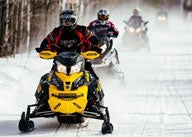




 Your Privacy Choices
Your Privacy Choices